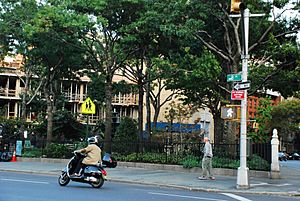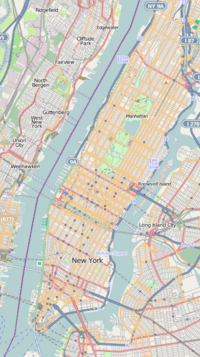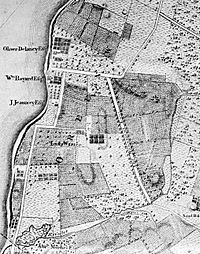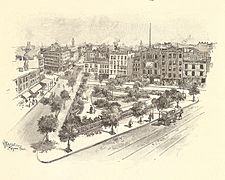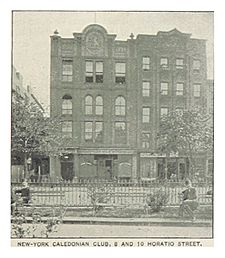Jackson Square Park facts for kids
Jackson Square Park is a small city park in New York City. It is located in the Greenwich Village area of Manhattan. The park is about 0.227 acres (918 m²) in size. It is surrounded by 8th Avenue, Horatio Street, and Greenwich Avenue. West 13th Street is interrupted by the park.
The park has a unique triangular shape. This shape comes from two old Native American footpaths. These paths later became streets in Greenwich Village. Over time, the city's street plan changed. This led to 8th Avenue being built through the area.
Jackson Square Park has changed a lot over the years. It started as an open gathering spot. Then it became a beautiful Victorian garden. Later, it was a children's playground. Today, it is a modern park used for many different activities.
Contents
How the Park's Shape Was Created
Ancient Footpaths Become City Streets
Long ago, two important footpaths crossed in this area. One path came from a trading spot by the river called "Sapohanikan." This path became what we now call Gansevoort Street. Horatio Street, which borders the park, grew from a path next to it.
The other footpath came from the south. This path became Greenwich Avenue, which is on the east side of the park. The way these two paths met created the park's triangle shape.
From Footpaths to Colonial Roads
By the late 1700s, these footpaths had become proper roads. New connecting roads also appeared to the north. In 1762, the city's first war memorial was built nearby. It was an obelisk honoring British Major General James Wolfe. He died in the Battle of Quebec. However, by 1773, the monument was gone from maps. No one knows why it was taken down.
Jackson Square: A Gathering Place (1811–1872)
The City Grid and Park Naming
In 1811, New York State decided on a new street plan. This plan created the grid system of streets we see today in Manhattan. 8th Avenue was extended south through this area in the 1830s. This extension became the western side of the park. Gansevoort Street was also shortened to simplify the many crossing roads.
The triangular area was likely named "Jackson Square" by the early 1850s. It was probably named after Andrew Jackson. He was the U.S. President from 1829 to 1837 and died in 1845.
A Hub for Community Events
Before 1872, Jackson Square was an open space. It was often used for public meetings and rallies. Up to 2,000 people would gather there. Speakers would use temporary platforms. At night, burning tar barrels, then gas lights, and later electric lights lit the area.
By the 1850s, Jackson Square became a regular spot for Fourth of July fireworks and music. This tradition lasted for many years. In the mid-1800s, the area was known as the "Scotch quarter." Many Irish immigrants also lived there.
Two large meeting places, Jackson Hall and Caledonian Hall, were located nearby. The Jackson Square Branch of The New York Public Library opened in 1888. George Washington Vanderbilt II helped fund it. Famous architect Richard Morris Hunt designed the building. The library branch closed in 1967.
Jackson Square Becomes a Park (1872–1888)
In 1872, improvements were made to Jackson Square. Walks were graded, and a railing was added. The triangular area was fenced in. It was covered with grass and small trees. In 1873, bluestone sidewalks were added around the outside.
However, the inside of the park was not open to the public. People could only look at it from outside the fence. A newspaper reported that children would reach through the railings to pull grass. Neighbors would sit around the coping on warm nights. At the time, many believed small green spaces should be kept closed. They feared too many people would damage them.
After years of public requests, Mayor Abram Hewitt worked to open small parks. In 1887, Parks superintendent Samuel Parsons Jr. and architect Calvert Vaux created a new design for Jackson Square.
By August 1888, the City Parks Commissioner officially opened "Jackson Park." Construction took four months. A new entrance was added. An asphalt walk, ten feet wide, went around the park's inside. Seats were placed along the walk. A drinking fountain was also installed. The park was called "Jackson Park" at first. But by 1889, "Jackson Square Park" became its common name. Samuel Parsons described the design. He said walks went along the fence. The center was a "great bouquet of brilliant flowers and leaves."
Jackson Square in the 20th and 21st Centuries
From Viewing Garden to Playground
In the early 1900s, ideas about city parks changed. People wanted parks to be more useful for city residents. They especially wanted them to help children and mothers.
Between 1910 and 1911, the park's main feature was removed. The large raised flower bed in the center was leveled. It was covered with gravel to create a playground. Swings and see-saws were put in. A sand pit was also dug for children to play in. By 1913, Jackson Square Park joined the "little farmers" program. This program let children grow their own flowers and vegetables. It started in 1902 in DeWitt Clinton Park. The idea spread across New York City.
The park was renovated in the 1930s. Seventeen pin oak trees were planted around the edge. A new wading pool replaced the old shower basin. New benches were also installed. The park became known as a great place for mothers and children. In 1971, a new fountain and jungle gym was added. It was a water spray for children that also looked like a decorative fountain.
Modern Park and Community Support
In 1966, a larger playground opened at Bleecker Street. This meant Jackson Square Park was less needed as a children's playground. In 1990, a big renovation project was finished. This project changed the park to how it looks today. New plants were added. The old iron fence and benches were restored. The main feature is a new cast-iron fountain. It has planters and a granite base. This fountain reminds visitors of the park's 19th-century look.
Since 2008, the Jackson Square Alliance has helped the park. This non-profit group helps maintain the park. They also encourage people to use and enjoy it.


